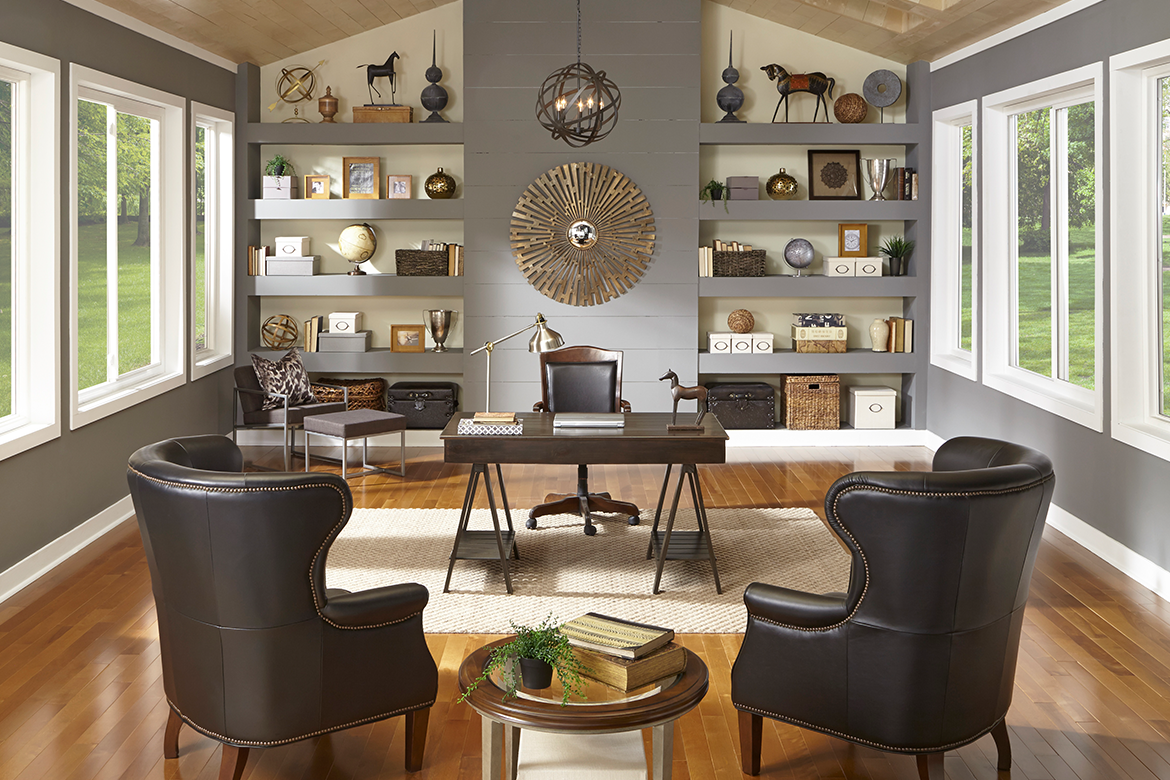Home improvements beautify a home, make it safer, increase efficiency, and add resale value. Aside from gaining these benefits, did you know many home improvements can also offset a portion of your tax bill? Some advantages you can enjoy immediately. Others benefit your wallet in the long run.
Related: 6 Home Upgrades to Help Protect Your Family
Energy Saving Home Improvements

Featuring our EnergyVue® Picture Window PW5420 and Casement Window CA5440
If you’re looking to create a more energy efficient home, you could be eligible for a tax break. Improvements you can claim on your taxes include solar electric (e.g. solar panels), solar water heating, small wind energy, geothermal heat pump, and fuel cells.
Other energy efficient improvements qualify as well. For instance, you can deduct a portion of your taxes if you make improvements that meet the standards set by the U.S. Department of Energy. These include insulation, exterior doors and windows, skylights, and certain roofing materials. This tax rule also includes specific types of heat pumps, water heaters, and HVAC systems.
Both of the above types of tax credits are set to expire at the end of 2021. However, tax rules are always changing. If you keep careful track each tax year, you may find previous credits extended or new ones that become available.
Enjoy Additional Savings with ENERGY STAR Upgrades
Products rated as ENERGY STAR help you save money while protecting the environment. Our vinyl window and door collections create a more energy efficient home, and lower the burden on your HVAC system. The WinGuard® Vinyl and EnergyVue® collections can deliver significant savings on your monthly utility bill without sacrificing elegance or style. Each collection includes options to achieve the coveted ENERGY STAR rating.
Related: 4 Factors That Make Patio Doors More Energy-Efficient
Capital Improvements
If you’ve bought your home and its value has gone up over the years, you may have to pay capital gains taxes when you sell. The good news is you can reduce the amount you’ll owe through certain home improvements. This is done by including these expenses in the cost basis of your house. While you can’t deduct expenses in the year you had your home improvements done, you can claim them the year you sell your home. Qualifying improvements include:
- Bedroom and bathroom additions
- Garage
- Roof replacement
- New windows and doors
- New pipes or duct work
- Installing new insulation
- Replacing walls and floors
- Upgraded HVAC system
- Installing fences or retaining walls
- Adding porches, patios, or decks
- Driveway and walkway replacements
- Wall to wall carpeting
- Installing new built in appliances
- Adding a home security system
- Extensive new landscaping additions
Essentially, capital improvements are those that improve a home’s value. Be sure to keep careful track of major improvements during the time you own your home. By doing this, you can significantly reduce the amount of tax you’ll owe when you sell your house. Currently, sellers can avoid capital gains taxes if their home is sold for a profit of $250,000 or less for single tax filers and $500,000 or less for joint filers if certain qualifications are met.
Capital gains tax benefits can be especially helpful if you’ve owned your home for a long time. In this scenario, property values often have significantly increased over the years. This means you’ll get a larger profit. In this type of situation, capital gains can really ease your tax burdens.
Related: Replacement Window Guide
Home Office Deductions

Featuring our EnergyVue® Horizontal Roller Window HR5410
The number of people who work on a remote status has been steadily increasing over the years. The gig economy has also resulted in a boost of freelancers and small business owners. However, the year 2020 completely transformed work structures for everyone else. Going forward, many people will continue to work remotely either as small business owners or as employees. The pandemic also contributed to the further growth of gig workers.
A recent PwC survey found 83% of employers said the shift to remote work in 2020 has been successful (up from 73% in June). While many companies are likely to resist full time remote work in the future, it’s clear many plan to have employees working from home at least a part of the time. This means employees will need efficient workspaces. The good news is you can deduct many items on your taxes if you work from home. You’ll have to meet certain criteria to qualify though. Here’s an overview.
- Freelancers or business owners who run their own work with a dedicated workspace in their homes can deduct 100% of improvements made to their offices.
- Freelancers or home businesses can deduct the percentage of the home used as office space (e.g. 15%) for overall home improvements. In other words, they can apply their office square footage as a percentage based tax break for major renovations that benefit the entire house.
- Employees may deduct certain home improvements if they meet specific criteria.
- Remote work is a condition of employment.
- A home office is needed for an employee to properly perform their work related duties.
- Remote work is necessary for the employer’s business to properly function.
For employees to claim a tax deduction, it’s important to understand they cannot be working from home by choice. Nor can they choose to work from home out of convenience. Work from home status must be a requirement made by an employer.
Related: 7 Upgrades to Enhance Your Remote Work Lifestyle
Accessibility/Medical Expenses

If you have to make adaptations to your home due to accessibility or medical reasons, you can usually deduct these on your taxes. Examples would be:
- Modifying a bathroom
- Lowering cabinets
- Widening doorways
- Adding handrails
- Installing a ramp
- Altering stairways or adding a lift
Changes must be medically-related. They cannot be for architectural purposes or aesthetic ones. Expenses must also exceed 7.5% of adjusted gross income to qualify.
Using Loans for Improvements
If you took out a home equity line of credit (HELOC) to make improvements, you may qualify for a tax break. The HELOC must specifically be used for home improvements that “substantially” improve your property value. If you qualify, you can write off the interest you paid on your loan.
Another scenario where you may qualify for a tax deduction is when you buy your house. For instance, you buy a fixer upper that needs substantial work. When taking out a mortgage, you decide to borrow extra money for renovations. In this case, you can deduct the interest on the portion of the loan that was designated for home improvements.
Home improvements are a good investment and add value to your house. If you can work them to your advantage come tax time, even better.




